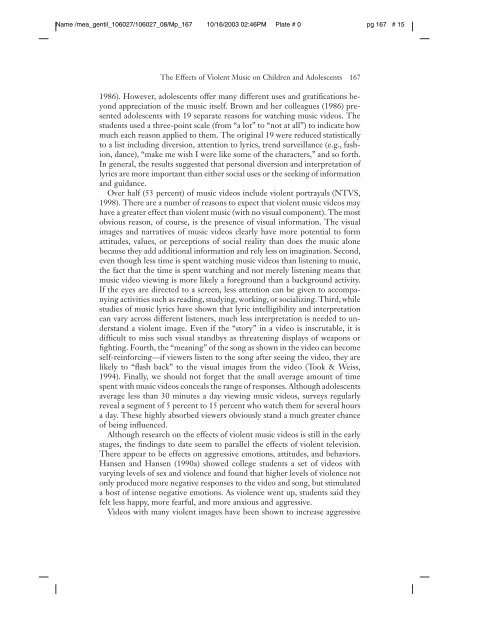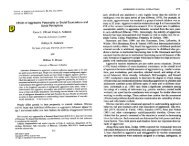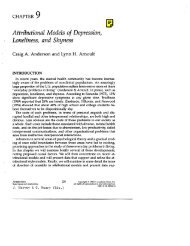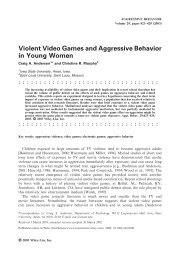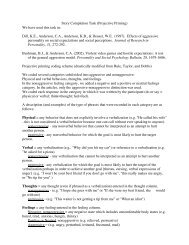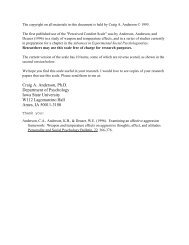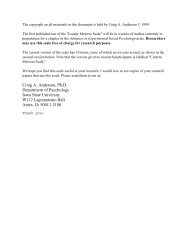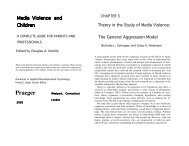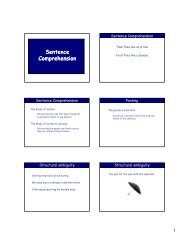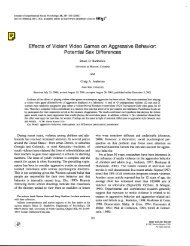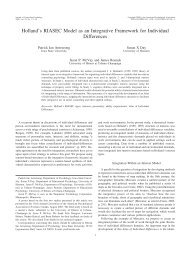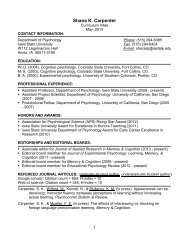The Effects of Violent Music on Children and Adolescents
The Effects of Violent Music on Children and Adolescents
The Effects of Violent Music on Children and Adolescents
You also want an ePaper? Increase the reach of your titles
YUMPU automatically turns print PDFs into web optimized ePapers that Google loves.
Name /mea_gentil_106027/106027_08/Mp_167 10/16/2003 02:46PM Plate # 0 pg 167 # 15<br />
<str<strong>on</strong>g>The</str<strong>on</strong>g> <str<strong>on</strong>g>Effects</str<strong>on</strong>g> <str<strong>on</strong>g>of</str<strong>on</strong>g> <str<strong>on</strong>g>Violent</str<strong>on</strong>g> <str<strong>on</strong>g>Music</str<strong>on</strong>g> <strong>on</strong> <strong>Children</strong> <strong>and</strong> <strong>Adolescents</strong> 167<br />
1986). However, adolescents <str<strong>on</strong>g>of</str<strong>on</strong>g>fer many different uses <strong>and</strong> gratificati<strong>on</strong>s bey<strong>on</strong>d<br />
appreciati<strong>on</strong> <str<strong>on</strong>g>of</str<strong>on</strong>g> the music itself. Brown <strong>and</strong> her colleagues (1986) presented<br />
adolescents with 19 separate reas<strong>on</strong>s for watching music videos. <str<strong>on</strong>g>The</str<strong>on</strong>g><br />
students used a three-point scale (from “a lot” to “not at all”) to indicate how<br />
much each reas<strong>on</strong> applied to them. <str<strong>on</strong>g>The</str<strong>on</strong>g> original 19 were reduced statistically<br />
to a list including diversi<strong>on</strong>, attenti<strong>on</strong> to lyrics, trend surveillance (e.g., fashi<strong>on</strong>,<br />
dance), “make me wish I were like some <str<strong>on</strong>g>of</str<strong>on</strong>g> the characters,” <strong>and</strong> so forth.<br />
In general, the results suggested that pers<strong>on</strong>al diversi<strong>on</strong> <strong>and</strong> interpretati<strong>on</strong> <str<strong>on</strong>g>of</str<strong>on</strong>g><br />
lyrics are more important than either social uses or the seeking <str<strong>on</strong>g>of</str<strong>on</strong>g> informati<strong>on</strong><br />
<strong>and</strong> guidance.<br />
Over half (53 percent) <str<strong>on</strong>g>of</str<strong>on</strong>g> music videos include violent portrayals (NTVS,<br />
1998). <str<strong>on</strong>g>The</str<strong>on</strong>g>re are a number <str<strong>on</strong>g>of</str<strong>on</strong>g> reas<strong>on</strong>s to expect that violent music videos may<br />
have a greater effect than violent music (with no visual comp<strong>on</strong>ent). <str<strong>on</strong>g>The</str<strong>on</strong>g> most<br />
obvious reas<strong>on</strong>, <str<strong>on</strong>g>of</str<strong>on</strong>g> course, is the presence <str<strong>on</strong>g>of</str<strong>on</strong>g> visual informati<strong>on</strong>. <str<strong>on</strong>g>The</str<strong>on</strong>g> visual<br />
images <strong>and</strong> narratives <str<strong>on</strong>g>of</str<strong>on</strong>g> music videos clearly have more potential to form<br />
attitudes, values, or percepti<strong>on</strong>s <str<strong>on</strong>g>of</str<strong>on</strong>g> social reality than does the music al<strong>on</strong>e<br />
because they add additi<strong>on</strong>al informati<strong>on</strong> <strong>and</strong> rely less <strong>on</strong> imaginati<strong>on</strong>. Sec<strong>on</strong>d,<br />
even though less time is spent watching music videos than listening to music,<br />
the fact that the time is spent watching <strong>and</strong> not merely listening means that<br />
music video viewing is more likely a foreground than a background activity.<br />
If the eyes are directed to a screen, less attenti<strong>on</strong> can be given to accompanying<br />
activities such as reading, studying, working, or socializing. Third, while<br />
studies <str<strong>on</strong>g>of</str<strong>on</strong>g> music lyrics have shown that lyric intelligibility <strong>and</strong> interpretati<strong>on</strong><br />
can vary across different listeners, much less interpretati<strong>on</strong> is needed to underst<strong>and</strong><br />
a violent image. Even if the “story” in a video is inscrutable, it is<br />
difficult to miss such visual st<strong>and</strong>bys as threatening displays <str<strong>on</strong>g>of</str<strong>on</strong>g> weap<strong>on</strong>s or<br />
fighting. Fourth, the “meaning” <str<strong>on</strong>g>of</str<strong>on</strong>g> the s<strong>on</strong>g as shown in the video can become<br />
self-reinforcing—if viewers listen to the s<strong>on</strong>g after seeing the video, they are<br />
likely to “flash back” to the visual images from the video (Took & Weiss,<br />
1994). Finally, we should not forget that the small average amount <str<strong>on</strong>g>of</str<strong>on</strong>g> time<br />
spent with music videos c<strong>on</strong>ceals the range <str<strong>on</strong>g>of</str<strong>on</strong>g> resp<strong>on</strong>ses. Although adolescents<br />
average less than 30 minutes a day viewing music videos, surveys regularly<br />
reveal a segment <str<strong>on</strong>g>of</str<strong>on</strong>g> 5 percent to 15 percent who watch them for several hours<br />
a day. <str<strong>on</strong>g>The</str<strong>on</strong>g>se highly absorbed viewers obviously st<strong>and</strong> a much greater chance<br />
<str<strong>on</strong>g>of</str<strong>on</strong>g> being influenced.<br />
Although research <strong>on</strong> the effects <str<strong>on</strong>g>of</str<strong>on</strong>g> violent music videos is still in the early<br />
stages, the findings to date seem to parallel the effects <str<strong>on</strong>g>of</str<strong>on</strong>g> violent televisi<strong>on</strong>.<br />
<str<strong>on</strong>g>The</str<strong>on</strong>g>re appear to be effects <strong>on</strong> aggressive emoti<strong>on</strong>s, attitudes, <strong>and</strong> behaviors.<br />
Hansen <strong>and</strong> Hansen (1990a) showed college students a set <str<strong>on</strong>g>of</str<strong>on</strong>g> videos with<br />
varying levels <str<strong>on</strong>g>of</str<strong>on</strong>g> sex <strong>and</strong> violence <strong>and</strong> found that higher levels <str<strong>on</strong>g>of</str<strong>on</strong>g> violence not<br />
<strong>on</strong>ly produced more negative resp<strong>on</strong>ses to the video <strong>and</strong> s<strong>on</strong>g, but stimulated<br />
a host <str<strong>on</strong>g>of</str<strong>on</strong>g> intense negative emoti<strong>on</strong>s. As violence went up, students said they<br />
felt less happy, more fearful, <strong>and</strong> more anxious <strong>and</strong> aggressive.<br />
Videos with many violent images have been shown to increase aggressive


